Article in English:
ID: P14.1
Title:
#Sex #Gender #Art:
«My Right for Porno»
Date:
September 24, 2014
Resource:
Context:
Meeting with exhibitors XXY and discussion during the meeting The Transformation of the Theme of Sexual / Gender Identity in Art Practices in Different Cultural Contexts
Balki, Minsk, Belarus
Balki, Minsk, Belarus
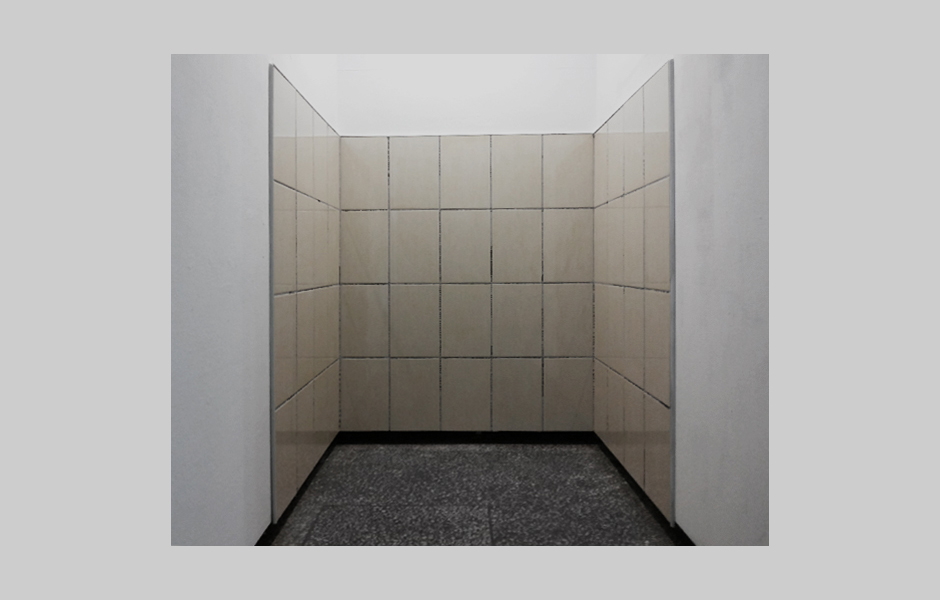
Sergey Shabohin:
Displacement Zones,
2014
Displacement Zones,
2014
Anna Loktionova:
Good evening! We are happy to welcome you at the discussion #Sex #Gender #Art in the Post-Soviet Space, which is held as a part of XXY art project. Today the participants of our meetings will be the artists whose works you can see at the exhibition. They are Anatoly Belov, Zhanna Gladko, Michail Gulin and Sergey Shabohin. Now I would like to invite them to present their works related to the issues of gender and sexual identity. And I would also suggest them to highlight how these topics are handled and presented in their local contexts.
Michail Gulin:
I will start with my video project I am not a Gay, which you can see at the exhibition. This performance belongs to the series I am not… where a number of issues are raised, not only gender identity and the basis for this series was rather a political situation in the country. I tried to understand some phobias and stereotypes of the Belarusian society and then to work with them. I would immediately note that all the performances in the series are characterized by theatricality, because I was aiming at creating a stereotypical image. In the performance I am not a Gay I look more like a drag queen, because it was important for me to have my message understood by people, and in the Post-Soviet space yet no difference can be found between, for example, drag queens, gays and transgender people. It was in 2008 and I should mention that with every passing year it is becoming more and more difficult to work in our urban environment. When I say «more difficult», I do not actually mean appearance — people in our country have already got used to seeing even pink hair. But the action itself.Here almost any action in the city is forced into political area. And this trend has become apparent especially in recent years.
One can pay the consequences to their fullest. As it happened during the performance A Personal Monument when my volunteers and I were rudely detained only for placing the cubes in the streets. For example, in the project I am not a Terrorist one of the places where the performance was held was a public market. I was peacefully shooting my video there. A year later I came to the same place but the shooting was banned. I was sent to the director who told me that I needed to write an official letter, etc. So I found out that in a 500-meters’ area from the metro station it was not allowed to shoot videos, neither was it possible to do inside the shops… What concerns the performance I am not a Gay, I need to say that it turned out to be pretty fun. I faced neither aggressive shouts nor negative reactions.
One can pay the consequences to their fullest. As it happened during the performance A Personal Monument when my volunteers and I were rudely detained only for placing the cubes in the streets. For example, in the project I am not a Terrorist one of the places where the performance was held was a public market. I was peacefully shooting my video there. A year later I came to the same place but the shooting was banned. I was sent to the director who told me that I needed to write an official letter, etc. So I found out that in a 500-meters’ area from the metro station it was not allowed to shoot videos, neither was it possible to do inside the shops… What concerns the performance I am not a Gay, I need to say that it turned out to be pretty fun. I faced neither aggressive shouts nor negative reactions.
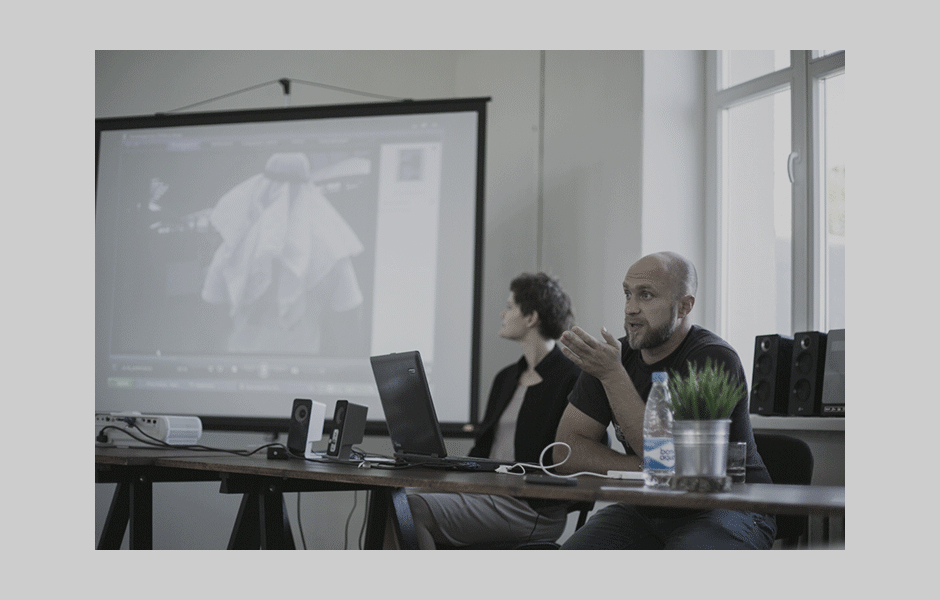
Anna Loktionova
and Michail GulinPhoto by K. Palakova
Anna Loktionova:
Do you link such a feedback can be explained by the famous Belarusian tolerance?
Michail Gulin:
I do not think that it is because of tolerance. Our people are not used to such performances and simply have no clue about how to react to them. In some cases I could see that the reaction was suppressed — people were passing by pretending not to be noticing me, even trying not to look in my direction. But in my opinion it was just the suppression of a natural reaction… If to speak about some possible situational patterns one might have calculated beforehand, in our context it is almost impossible to do it. For example, I thought that the simplest performance would be I am not American. However, everything finished up with my detention and the topic turned up to be unacceptable. According to my script, I had to walk from one McDonald’s restaurant to another, purchasing a bigger hamburger there and then continuing my stroll. First, the policemen walked past me, but then they returned. And the dialogue was as follows: «… And what if the McDonald’s administration does not like your performance?» — «So let us wait and see» — «And if the ambassador passes by and he would not like it…» That is, it was such a preventive detention which fit the formula of «just in case» — to register, to draw up a report according to a «just in case» article. That is, there are certain areas, and if you do not know them, you can face them out of the blue.
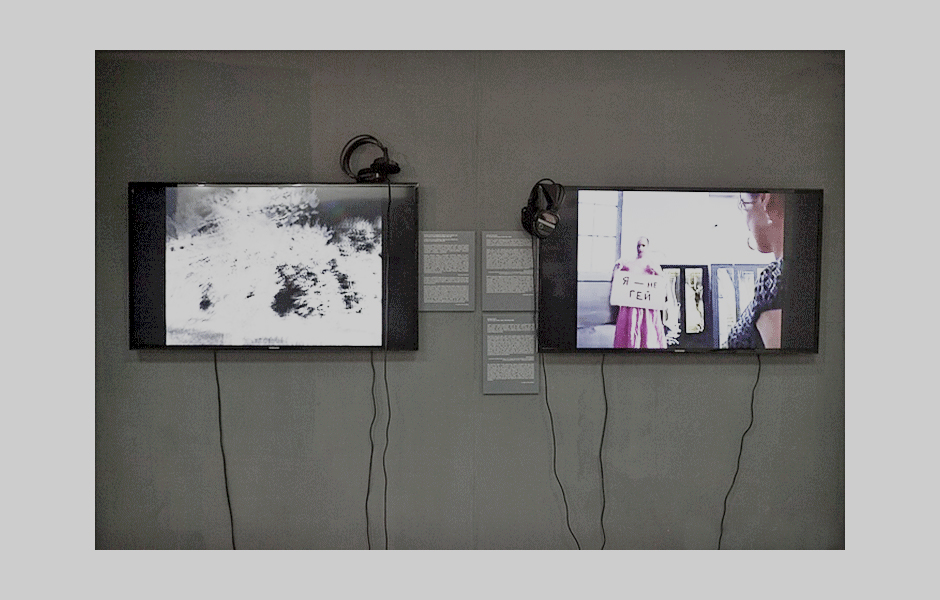
Michail Gulin:
exposition of XXY project,
2014
Photo by
Victoria Scherbakova
exposition of XXY project,
2014
Photo by
Victoria Scherbakova
Anatoly Belov:
Everything I do is somehow a part of my life, a reflection on what is happening to me and around me. In 2004 I got involved into contemporary art, the first works appeared already then being rooted in personal stories and experience. Then I made an art book called The Most Pornographic Book in the World. Having the education of a book artist, and I was interested in transforming a sort of anti-designer’s book into an art object. The format was absolutely not a book-like, that is I completely ignored everything that I had learned about book-making.
The film, which is presented at the exhibition, was shot thanks to getting into Pinchuk Award short-list and thus I got a budget for making it. For a long time I had been dreaming of shooting a movie, but this pleasure is quite an expensive one. In this film all the media I had been working with got blended together: music, graphics, text — and I would like to continue working with cinema and music in future. Sex Drugs Rock-N-Rollis my first experience in cinema. All the actors in this film are amateurs. We had been looking for the main character for a very long time. According to the scenario, it is an Austrian artist who comes to Kiev, where he meets a couple — a male and a female — and the love triangle is born. For this part in my movie I needed to find a very handsome man. Actually, it turned out to be very difficult to do, since all the handsome models I contacted immediately refused to take part as soon as they heard that they were supposed to play a gay man’s part. Although at the same time they often posed in homoerotic photo shoots. Finally, quite by accident, while looking through the portfolios of different agencies we found a guy from Odessa. I invited him, and he adequately accepted the proposal, although he was not a gay.
The film, which is presented at the exhibition, was shot thanks to getting into Pinchuk Award short-list and thus I got a budget for making it. For a long time I had been dreaming of shooting a movie, but this pleasure is quite an expensive one. In this film all the media I had been working with got blended together: music, graphics, text — and I would like to continue working with cinema and music in future. Sex Drugs Rock-N-Rollis my first experience in cinema. All the actors in this film are amateurs. We had been looking for the main character for a very long time. According to the scenario, it is an Austrian artist who comes to Kiev, where he meets a couple — a male and a female — and the love triangle is born. For this part in my movie I needed to find a very handsome man. Actually, it turned out to be very difficult to do, since all the handsome models I contacted immediately refused to take part as soon as they heard that they were supposed to play a gay man’s part. Although at the same time they often posed in homoerotic photo shoots. Finally, quite by accident, while looking through the portfolios of different agencies we found a guy from Odessa. I invited him, and he adequately accepted the proposal, although he was not a gay.

Anna Loktionova,
Anatoly Belov,
Sergey Shabohin,
Zhanna Gladko
Photo by K. Palakova
Anatoly Belov,
Sergey Shabohin,
Zhanna Gladko
Photo by K. Palakova
A question from the audience:
Can you, please, tell us more about the exhibition Ukrainian Body. Why was it closed? Was this due to the severe censorship in Ukraine?
Anatoly Belov:
The situation with this exhibition was rather connected with the specifics of the place than with censorship, in principle. A few years ago at the Kyiv-Mohyla Academy the Center of Contemporary Art was functioning, which later moved to another place, and in its place the Center of Visual Culture continued its activity — a leftist activist educational association. It was in the framework of the CVC that the exhibition Ukrainian Body was shown. But for the rector of the Academy the existence of both the CCA and the CVC had always been a thorn in the eye, so the exhibition Ukrainian Body was a good opportunity for him to stop the center’s activities, arguing his position with the claim that the exhibition dealt with corporeality and contained nudity.
Two of my works were exhibited there. One had images of people who were shooting selfies in the mirror with the inscription My Porno— My Right. In the pictures I tried to create a sense of staying behind the glass in a police station: a man was looking into the mirror, but in fact he was being watched. The project was dedicated to the law, which forbade the storage of pornography on one’s computer, because in this way it could be interpreted as a distribution of pornographic videos. Also the providers were supposed to inform about the clients who logged on pornographic sites. Before that, there had been a big pedophile scandal in the Artek camp, and under the guise they decided to tighten the screws. In addition, I exhibited several works from my project The Most Pornographic Book in the World.
Apart from my works there were claims to Mikalay Ridny’s video Rada (2005). The work consisted of two screens; one demonstrated the voting process, the other one — cookies made in the form of animals that were jumping one by one into a woman’s vagina. Although the works were pretty old, many of them had already been displayed in numerous shows, but the claims somehow arose only at that time.
Two of my works were exhibited there. One had images of people who were shooting selfies in the mirror with the inscription My Porno— My Right. In the pictures I tried to create a sense of staying behind the glass in a police station: a man was looking into the mirror, but in fact he was being watched. The project was dedicated to the law, which forbade the storage of pornography on one’s computer, because in this way it could be interpreted as a distribution of pornographic videos. Also the providers were supposed to inform about the clients who logged on pornographic sites. Before that, there had been a big pedophile scandal in the Artek camp, and under the guise they decided to tighten the screws. In addition, I exhibited several works from my project The Most Pornographic Book in the World.
Apart from my works there were claims to Mikalay Ridny’s video Rada (2005). The work consisted of two screens; one demonstrated the voting process, the other one — cookies made in the form of animals that were jumping one by one into a woman’s vagina. Although the works were pretty old, many of them had already been displayed in numerous shows, but the claims somehow arose only at that time.
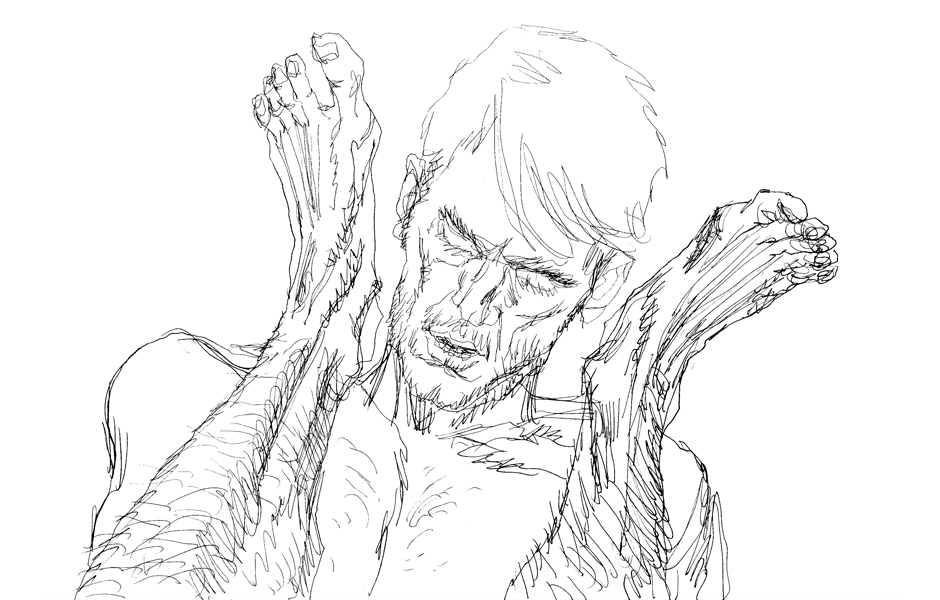
Anatoly Belov:
The Most Pornographic
Book in the World
Fragment
The Most Pornographic
Book in the World
Fragment
Sergey Shabohin:
At the exhibition XXY I showed my work Displacement Zones. This is one of the two works that are usually left unnoticed by the exhibition visitors. The first one belongs to Alaksiej Łunioŭ and it is attached to the ceiling. Whereas mine is located in the pass way which used to lead to a WC. I built a dead end there, an impromptu zone, which resembles a typical bathroom with typical tiles that can be found in any public toilet. And the most important thing you should pay attention to are inscriptions I have been collecting since 2006 in the men’s toilets in Belarus. Unseen at first glance they are placed along the seams between the tiles. They actually contain many different topics — from declarations of love, political and subcultural statements to homophobia and aggression — in fact, it looks like an alternative chat for men. It was important for me to move these private messages into the public space, because, in principle, very few people are aware of what men write in the men’s toilets. I saw how many people actually got surprised leaning about the existence of such a practice.
The inscriptions are placed exactly along the seams because the tiles in public WCs are constantly scrubbed and cleaned, on the whole sterility is typical of Minsk. But we have displaced zones — clubs, various other spaces where censorship retreats and many things are allowed. And it is visible in these tiles: everything that is considered to be offensive in our society can be written somewhere in a WC at the Central Railway Station.
This installation is part of my larger project I have been working with since 2011 and which is called Practice of Subordination. It is a sort of a total archive of images, performances and art objects dedicated to Minsk and my feelings about the city and, in principle, about Belarus. In fact, it is a collection of objects of fear. These are the most common items that carry a charge of oppression and aggression. We encounter them every day at the household level, and every day we are forced to fit some boundaries. It was important for me to find images that carry a charge of aggression and what is more important — the aggression on the part of the state aimed at the individual. The main slogan of the project is The Government Aims at One, the Individual Aims at Two.
In Belarus there are few free zones, but the state has learnt to dominate even them. At the moment I am preparing a literally traveling collection I want to finish this project with.
The inscriptions are placed exactly along the seams because the tiles in public WCs are constantly scrubbed and cleaned, on the whole sterility is typical of Minsk. But we have displaced zones — clubs, various other spaces where censorship retreats and many things are allowed. And it is visible in these tiles: everything that is considered to be offensive in our society can be written somewhere in a WC at the Central Railway Station.
This installation is part of my larger project I have been working with since 2011 and which is called Practice of Subordination. It is a sort of a total archive of images, performances and art objects dedicated to Minsk and my feelings about the city and, in principle, about Belarus. In fact, it is a collection of objects of fear. These are the most common items that carry a charge of oppression and aggression. We encounter them every day at the household level, and every day we are forced to fit some boundaries. It was important for me to find images that carry a charge of aggression and what is more important — the aggression on the part of the state aimed at the individual. The main slogan of the project is The Government Aims at One, the Individual Aims at Two.
In Belarus there are few free zones, but the state has learnt to dominate even them. At the moment I am preparing a literally traveling collection I want to finish this project with.

Anna Loktionova and
Sergey Shabohin
Photo by K. Palakova
Sergey Shabohin
Photo by K. Palakova
Zhanna Gladko:
I will also make a short presentation of my works shown at the exhibition. This is a series of photographs printed on metal — nine self-portraits and one portrait. The series is entitled Inciting Force. I see this project as possessing several levels, but I would try to speak about only one of them, which was actually suggested by the exhibition curators. This is an attempt to research the woman’s role and place in the system of patriarchal society where she is usually viewed from the position of Other or the minority, taking the role of a passive object — «mysterious, sexy and beautiful» with a man who leads in all the spheres being an active and successful subject. Making use of the instruments of fashion industry I try to show a stereotypical male’s perception of feminine beauty and sexuality thus presenting it as a more topical issue. My goal is to overturn the preset code.
All the images from the series are ambivalent, contradictory and conflicting. Two photographs have already been presented in the gallery as a part of my solo exhibition dedicated to the relationship with my father. In one of the photographs I try on my father’s clothes: on the one hand, it is a way of protest, an attempt to gain my freedom of expression, freedom for personal identity. On the other hand, this is an attempt to comply with the father’s authority, to take up the masculine position of the subject, to acquire courage and strength. In another picture, I use the attributes associated with a man’s world, and it is the image of the opposition of femininity and sexuality of the family’s asexual space.
In this series, an image of female aggression and demonism is also present. It shows the supposedly historically justified women’s position imposed by religion and society in a subordinate depressed state, in the context of the myth of the Fall, so I’m taking a sadomasochistic gag but instead of the ball I make use of an apple…
All the images from the series are ambivalent, contradictory and conflicting. Two photographs have already been presented in the gallery as a part of my solo exhibition dedicated to the relationship with my father. In one of the photographs I try on my father’s clothes: on the one hand, it is a way of protest, an attempt to gain my freedom of expression, freedom for personal identity. On the other hand, this is an attempt to comply with the father’s authority, to take up the masculine position of the subject, to acquire courage and strength. In another picture, I use the attributes associated with a man’s world, and it is the image of the opposition of femininity and sexuality of the family’s asexual space.
In this series, an image of female aggression and demonism is also present. It shows the supposedly historically justified women’s position imposed by religion and society in a subordinate depressed state, in the context of the myth of the Fall, so I’m taking a sadomasochistic gag but instead of the ball I make use of an apple…

Anna Loktionova,
Zhanna Gladko,
Anatoly Belov
Photo by K. Palakova
Zhanna Gladko,
Anatoly Belov
Photo by K. Palakova
For another portrait I invited my colleague — the artist Sergey Shabohin — and tried to «impose» on him my image, thus depriving him of his individuality. The next image — that of a transvestite — shows a male’s ironic perspective of women in queer community. I used a makeup of the famous transvestite Divine. The following work was created specifically for the magazine «Mastactva» («Art»). I was asked to create a work that would become my manifesto, and I made a self-portrait. From various magazines I cut out the portraits of Belarusian successful, respected and popular male artists from the sphere of contemporary art and stuck them on my body. This image is also ambivalent — on the one hand, my body has been transformed into an «iconostasis» or a billboard. On the other hand, this is irony, an attempt to look at the problem that exists in the field of contemporary art — the problem of gender imbalance and patriarchal nature of the system.
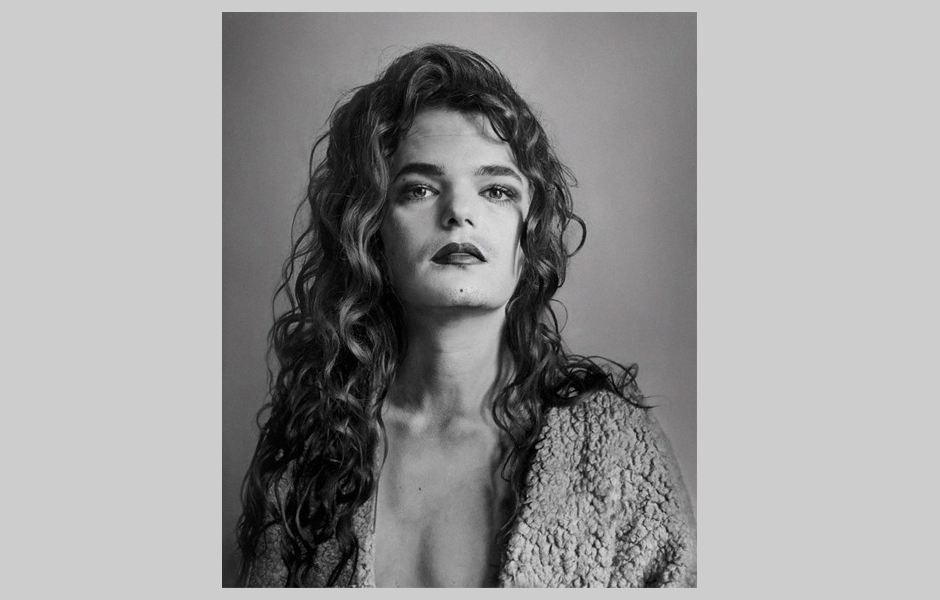
Zhanna Gladko:
Inciting Force,
2014
Fragment
Inciting Force,
2014
Fragment
A question from the audience:
I would like to return to the issue of censorship, and I wonder how the perception of gender and sexual topics in the Ukranian society has changed after the case of the exhibition Ukrainian Body closing? For example, how are gay prides held?
Anatoly Belov:
We do not have censorship as such. In the case of Ukrainian body, as I said earlier, the main reason was in the rector’s desire, who did found a pretext. After the CVC at the Kyiv-Mohyla Academy was closed, it functioned at various other venues. Now they are creating a new space. What concerns, for example, gender distribution in the art field, we have no problems with it, and the most successful artists are women. For example, Zhanna Kadyrava, Lada Nakanechnaya, Lesia Chamenka — these are some of the most successful and very active female authors.
As for gay prides, they are still held informally. Last time the gay pride was organized inside a closed film studio. But the situation was kept very much secret, and many LGBTQ-activists did not know till the last second where the pride would be held. Finally, when they learnt about the location and arrived there, there had already happened the leak of information, and near the studio walls elderly ladies, Cossacks and other people could already be seen. Nevertheless, recently we have had a film festival with a program of gay movies, where an episode from my movie was also shown. There was also a discussion platform held within the show. You had to get registered to enter there, but it was possible to attend it.
As for gay prides, they are still held informally. Last time the gay pride was organized inside a closed film studio. But the situation was kept very much secret, and many LGBTQ-activists did not know till the last second where the pride would be held. Finally, when they learnt about the location and arrived there, there had already happened the leak of information, and near the studio walls elderly ladies, Cossacks and other people could already be seen. Nevertheless, recently we have had a film festival with a program of gay movies, where an episode from my movie was also shown. There was also a discussion platform held within the show. You had to get registered to enter there, but it was possible to attend it.
A question from the audience:
Is the topic of sexuality tabooed at the official level in Ukraine?
Anatoly Belov:
On the one hand, it is not. On the other hand, a patriarchal model of understanding sexuality is clearly dominating. Changes occur, but they happen mostly through the youth, who start doing something more openly. The EURO 2012 which took place in Kiev also contributed to that trend. A lot of different people from various countries came and the city changed. For example, Elton John was supposed to perform, and there was also a picket with homophobic posters, but those were not supported by passers-by. It was also a good sign that something was actually changing.
A question from the audience:
I have a question to Sergey. You spoke about the social body of the Belarusians, who constantly face interference into their private life. But doesn’t it seem to you that it is also affected by the way cultural institutions in Belarus also censor what artists propose them. For example, in Homiel at the exhibition Alphabet a question rose regarding the video work where a close-up of a fragment of a woman’s body where a bellybutton gradually become a pubic area was shown. Or is it connected exclusively with the institution’s conservative views? Or here we can also trace some sort of an order aimed at regulating the body and corporeality?
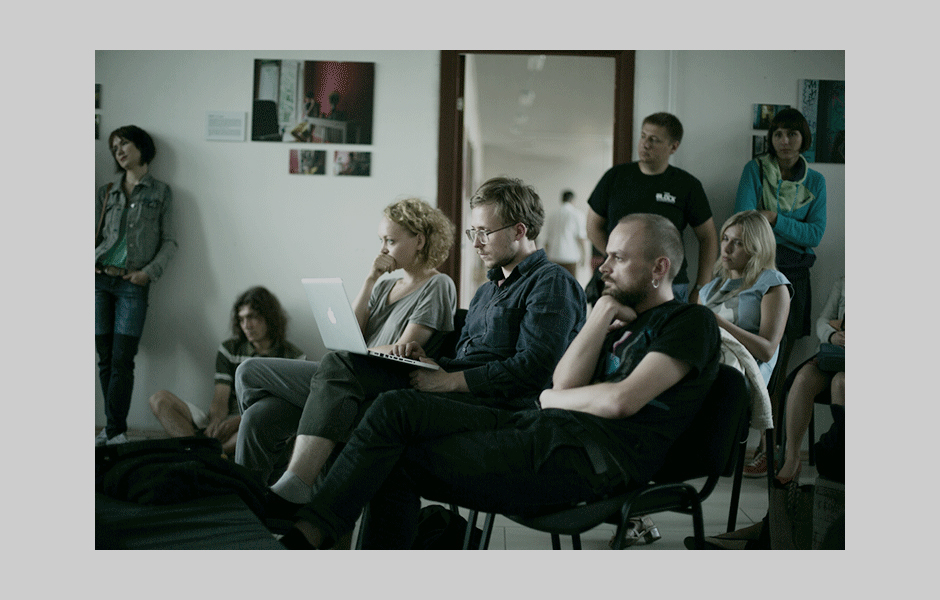
Photo by K. Palakova
Sergey Shabohin:
It seems to me that the fanaticism with which the Belarusians have recently been treating clothing and various objects is primarily connected with the total suppression of the social body. Physical body is the only thing that belongs to you. It is an illusion, but still… All these laws that we have in abundance, to a very large extend are blocking our feeling of freedom of our bodies, and I understand why we do not have the culture of protests unlike the Ukrainians or Poles, for example.
Anna Loktionova:
Thank you for your presentations. What we can say for sure is that in Ukraine the problem of the women’s place in the art system of coordinates is visually not present, whereas in Belarus it is felt and is constantly discussed. For example, as a part of the Zero Radius project, where a number of Belarusian female artists made the issue of the woman’s place in the local art space present. It is also typical, perhaps, for the entire Post-Soviet space to confuse such terms as homosexuality, pornography, sexuality and gender. They are all mixed up into one ball making it easier to manipulate objects and subjects who deal with these topics, as well as manipulating public opinion.
Nevertheless, the artists do raise these issues, pose questions, provoke debates, and all these move us forward.
Nevertheless, the artists do raise these issues, pose questions, provoke debates, and all these move us forward.